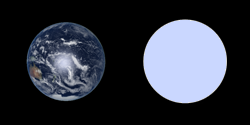| Observation data Epoch J2000 [1] Equinox J2000 [1] | |
|---|---|
| Constellation | Phoenix |
| Right ascension | 00h 02m 10.72420s [2] |
| Declination | −43° 09′ 55.3906″ [2] |
| Apparent magnitude (V) | 12.76 [3] |
| Characteristics | |
| Spectral type | DAP5.8 [4] |
| Apparent magnitude (B) | 13.12 [1] |
| Apparent magnitude (V) | 12.76 [3] |
| Apparent magnitude (RKC) | 12.82 [5] |
| Apparent magnitude (IKC) | 12.66 [5] |
| Apparent magnitude (J) | 12.60 ± 0.03 [5] |
| Apparent magnitude (H) | 12.43 ± 0.02 [5] |
| Apparent magnitude (KS) | 12.45 ± 0.02 [5] |
| Astrometry | |
| Radial velocity (Rv) | -58.8 ± 10.8 [6] km/s |
| Proper motion (μ) | RA: 613.785 mas/yr [2] Dec.: -686.989 mas/yr [2] |
| Parallax (π) | 120.0143±0.0215 mas [2] |
| Distance | 27.176 ± 0.005 ly (8.332 ± 0.001 pc) |
| Absolute magnitude (MV) | 13.39±0.03 |
| Details [7] | |
| Mass | 0.83±0.02 M☉ |
| Radius | 0.0097±0.0001 [8] R☉ |
| Luminosity | 4.37+0.42 −0.38×10−4 L☉ |
| Surface gravity (log g) | 8.37±0.02 cgs |
| Temperature | 8,506±122 [8] K |
| Age | 1.83±0.18 [note 1] Gyr |
| Other designations | |
| GJ 915, EG GR 165, L 362-81, LAWD 96, LFT 1849, LHS 1005, LP 988-88, LTT 9857, WD 2359-434, 2MASS J00021076-4309560 [1] | |
| Database references | |
| SIMBAD | data |
Location of WD 2359−434 in the constellation Phoenix | |
WD 2359-434 (Gliese 915, LHS 1005, L 362-81) is a nearby degenerate star (white dwarf) of spectral class DAP5.8, [4] the single known component of the system, located in the constellation Phoenix, the nearest star in this constellation.

